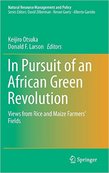In Pursuit of an African Green Revolution: Views from Rice and Maize Farmers' Fields

The Green Revolution in Asia increased agricultural productivity, boosted food production, and also contributed to economic development. Is a Green Revolution also possible in Africa? Small-scale farmers make up the majority of the population in Sub-Saharan Africa, but can a Green Revolution increase their incomes and help eradicate poverty? The book explores the possibility of a Green Revolution for Sub-Saharan Africa with focuses on rice and maize. It employs a wealth of examples and numerical data to present current status, issues, and prospects and possibilities for the future.
The book is a compilation of the research findings from a project implemented by the JICA Research Institute called "the empirical analysis on expanding rice production in Sub-Saharan Africa," led by Keijiro Otsuka, a professor at the National Graduate Institute for Policy Studies (GRIPS), and the results of research concerning maize cultivation performed by Donald F. Larson of the World Bank. Otsuka and Larson also served as editors of the book.
The Fourth Tokyo International Conference on African Development (TICAD IV) in 2008 saw the announcement of an initiative, the Coalition for African Rice Development (CARD), aimed at doubling Africa's rice production in ten years. This book aims to perform an empirical analysis of the contribution this initiative has made to increasing rice production and reducing poverty.
In the book's Foreword, Ichiro Tambo, director of the JICA-RI states, "The future of Africa's growth relies greatly on the performance of the agricultural sector ... Agricultural development has been essential for poverty reduction and food security in Sub-Saharan Africa, and one of the major cereal crops that has great potential for achieving these goals is rice."
The book makes the following three statements about past efforts to bring about a Green Revolution in Africa: First, a rice Green Revolution is possible based primarily on the transfer and adaptation of technology and management practices from Asia, a process that is already begun in some places. Second, a maize Green Revolution is possible based on the establishment of new productive farming systems; however the relevant experience is limited in comparison to the new rice technologies. Third, not only "improved technologies" but also "improved management practices" are the keys to Green Revolution in Sub-Saharan Africa. In particular, it stresses the importance of acquiring cultivation techniques through training.
According to Otsuka and Larson, rice is not the most important staple crop in Africa, but it is growing in importance. They believe the success of rice can serve as a model for a series of Green Revolutions in other food crops. They also state that while worldwide the number of rural poor has fallen in recent decades, those in Sub-Saharan Africa are increasing. Therefore, a Green Revolution must be scaled up in Africa and it will be important to involve small-scale farmers.
After an introduction by the two editors entitled "Why an African Green Revolution Is Needed and Why It Must Include Small Farms," the book provides case studies concerning rice in Mozambique, Tanzania, Uganda, north Ghana, and Senegal and maize in the Kenyan highlands and Uganda. The final chapter, entitled "Conclusions: Strategies Towards a Green Revolution in Sub-Saharan Africa" contains suggestions for delivering a Green Revolution.
scroll